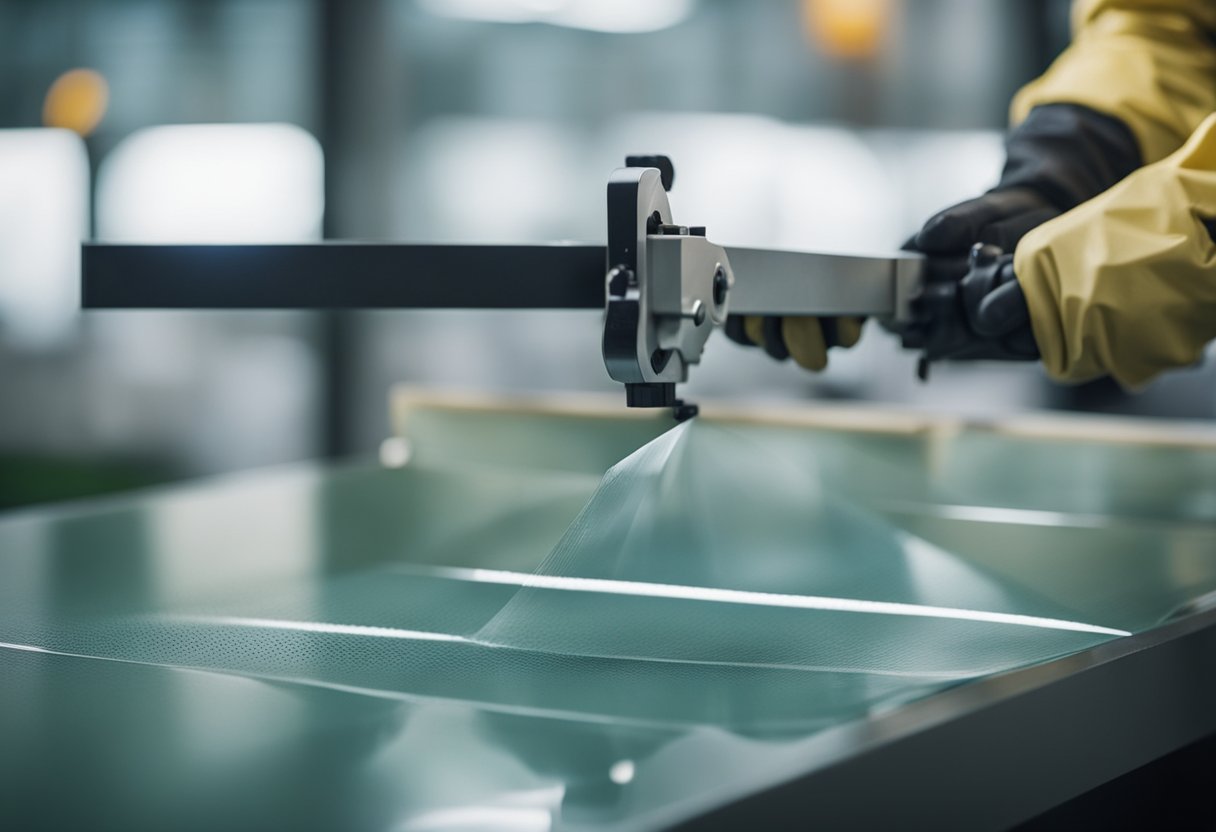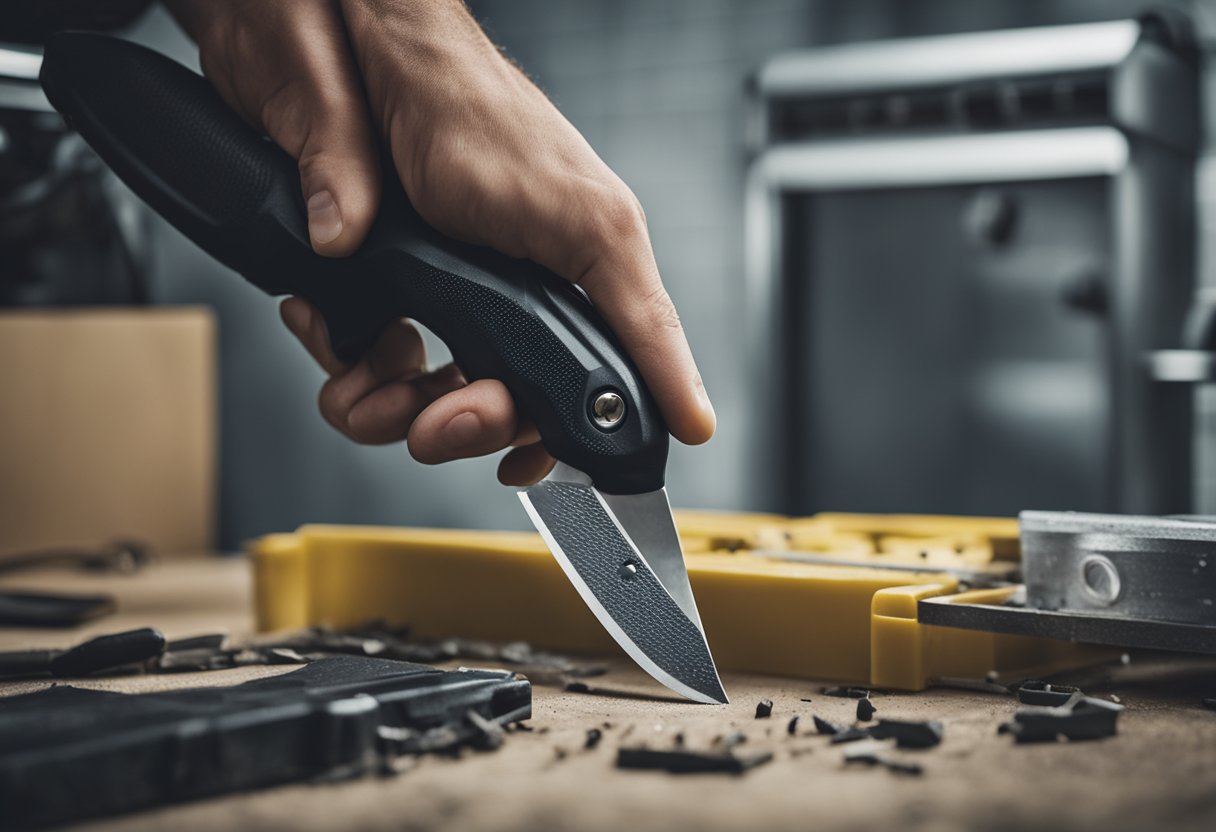Cutting a hole in plastic can be a challenging task, especially if you don’t have the right tools or techniques. Whether you’re working on a DIY home improvement project or need to create drainage holes in plastic containers, it’s important to know how to cut plastic without breaking it. In this article, I will share some tips and tricks on how to cut a hole in plastic, including the types of plastic, tools, and safety precautions you should take.
Understanding the Types of Plastic is the first step in cutting holes in plastic. There are different types of plastic, and each one requires a different approach to cut. For example, thin plastic sheets can be cut with a utility knife or scissors, while thicker plastic sheets require a saw. Plastic containers made of PVC or ABS can be cut with a hole saw or a Dremel tool. It’s important to choose the right tool for the job to avoid damaging the plastic.
Choosing the Right Tools is crucial for cutting holes in plastic. Some of the tools you may need include a utility knife, scissors, saw, hole saw, Dremel tool, or a hot knife. Each tool has its own advantages and disadvantages, and you should choose the one that works best for the plastic you are cutting. Additionally, you should take the necessary safety precautions to avoid injuries while cutting plastic.
Key Takeaways
- Understanding the types of plastic is crucial for cutting holes in plastic.
- Choosing the right tools can make the cutting process easier and more efficient.
- Taking safety precautions is essential to avoid injuries while cutting plastic.
Understanding the Types of Plastic
https://www.youtube.com/watch?v=K3TL5k243YU&embed=true
As someone who frequently works with plastic, it’s important to understand the different types of plastic and their properties. This knowledge can help you choose the appropriate tools and techniques for cutting and shaping plastic.
Common Types of Plastic
PVC
PVC, or polyvinyl chloride, is a common type of plastic used in construction, plumbing, and electrical applications. It is rigid and durable, making it ideal for pipes and fittings. PVC can be cut with a saw or a specialized PVC cutter.
Acrylic
Acrylic, also known as plexiglass, is a clear plastic that is often used in place of glass. It is lightweight and shatter-resistant, making it a popular choice for windows, picture frames, and other applications where glass could be dangerous. Acrylic can be cut with a saw or a specialized acrylic cutter.
HDPE
HDPE, or high-density polyethylene, is a versatile plastic that is commonly used in packaging, toys, and household items. It is strong, lightweight, and resistant to chemicals and UV radiation. HDPE can be cut with a saw or a specialized HDPE cutter.
Tips for Cutting Hard Plastic
When cutting hard plastic, it’s important to use the right tools and techniques to avoid cracking or shattering the material. Here are a few tips:
- Use a saw or cutter designed for the specific type of plastic you are working with.
- Apply steady pressure and use a slow, even motion when cutting.
- Use a lubricant or coolant to reduce heat and friction.
- Support the plastic on both sides of the cut to prevent it from bending or warping.
- Wear protective gear, such as gloves and eye protection, to prevent injury.
Conclusion
By understanding the different types of plastic and their properties, you can choose the appropriate tools and techniques for cutting and shaping plastic. Whether you are working with PVC pipe, acrylic sheets, or other types of plastic containers, following these tips can help you achieve clean, precise cuts without damaging the material.
Choosing the Right Tools
https://www.youtube.com/watch?v=uII0G89fONs&embed=true
When it comes to cutting holes in plastic, choosing the right tools is essential to ensure a clean and precise cut. Here are some of the tools that I recommend for cutting holes in plastic:
Drill Bits
Drill bits are an essential tool for making small, uniform holes in plastic. They come in various sizes and types, allowing you to choose one based on the hole size you need to make. High-speed steel drill bits are ideal for smooth, soft plastics like polyethylene. When using drill bits, it’s important to use low to medium drill speeds to prevent overheating and melting of the plastic.
Jigsaw
A jigsaw is a versatile cutting tool that can be used to make both straight and curved cuts in plastic. When using a jigsaw, it’s important to use the correct blade for the job. For cutting plastic, I recommend using a blade with fine teeth that can cut through the plastic without melting it.
Hole Saw
A hole saw is a cylindrical saw with a pilot drill bit in the center that is used to make large holes in plastic. Hole saws come in various sizes, and you can choose one based on the size of the hole you need to make. When using a hole saw, it’s important to use low to medium drill speeds to prevent overheating and melting of the plastic.
Utility Knife
A utility knife is a versatile cutting tool that can be used to make both straight and curved cuts in plastic. When using a utility knife, it’s important to use a sharp blade and apply even pressure to ensure a clean cut.
Rotary Tool
A rotary tool, such as a Dremel, is a versatile cutting tool that can be used to make both straight and curved cuts in plastic. When using a rotary tool, it’s important to use the correct attachment for the job and to apply even pressure to ensure a clean cut.
Hot Knife
A hot knife is a cutting tool that uses heat to melt through plastic. Hot knives are ideal for cutting through thick or hard plastics, such as PVC. When using a hot knife, it’s important to use safety glasses and to keep the blade clean to prevent it from sticking to the plastic.
Overall, when choosing the right tools for cutting holes in plastic, it’s important to consider the type of plastic you’re working with, the size of the hole you need to make, and the type of cut you need to make. With the right tools and techniques, you can achieve a clean and precise cut every time.
Preparation Before Cutting
Before cutting a hole in plastic, it is important to prepare properly to ensure a clean and precise cut. Here are some steps you should take before you start cutting:
Choose the Right Tools
To cut a hole in plastic, you will need the right tools. You can use a variety of tools to cut plastic, including a jigsaw, a hole saw, a Dremel tool, or a drill. The choice of tool will depend on the size and shape of the hole you want to cut, as well as the thickness of the plastic.
Mark the Hole
Once you have chosen the right tool, you need to mark the hole on the plastic. You can use a pencil or a marker to mark the hole. Make sure the mark is clear and visible, so you can cut the hole accurately.
Secure the Plastic
Before you start cutting, it is important to secure the plastic. You can use clamps to hold the plastic in place, or you can use scrap wood or plywood to create a support for the plastic. This will prevent the plastic from moving while you are cutting.
Lubricate the Tool
If you are using a jigsaw or a hole saw, it is important to lubricate the tool before you start cutting. This will prevent the plastic from melting and sticking to the tool. You can use a lubricant such as WD-40 or cooking spray to lubricate the tool.
Safety Precautions
When cutting plastic, it is important to take safety precautions. Wear safety goggles to protect your eyes from flying plastic. Also, make sure you are working in a well-ventilated area to avoid inhaling plastic dust.
Steps to Cut a Hole in Plastic
https://www.youtube.com/watch?v=GpbWRNfSj4o&embed=true
Cutting a hole in plastic may seem like a daunting task, but with the right tools and techniques, it can be done quickly and easily. Here are the steps to follow:
-
Choose the right cutting tool: There are several tools you can use to cut a hole in plastic, including a drill, rotary tool, hand saw, or utility knife. Consider the thickness and type of plastic you are working with, as well as the size of the hole you need to cut, to determine the best tool for the job.
-
Mark the hole: Use a marker or pencil to mark the center of the hole on the plastic. If you are using a drill, you may want to create a pilot hole first to make it easier to guide the drill bit.
-
Cut the hole: If you are using a drill, attach the appropriate size drill bit and drill into the plastic at a low speed. If you are using a rotary tool, attach a cutting disc and cut along the marked line. If you are using a hand saw or utility knife, score the plastic along the marked line and then saw or cut through it.
-
Smooth the edges: Once the hole is cut, use sandpaper or a file to smooth any rough edges or burrs.
It’s important to take your time and work carefully when cutting a hole in plastic. Remember to wear safety goggles and gloves, and follow all manufacturer instructions for the tools you are using. With a little practice, you’ll be able to cut clean, precise holes in plastic with ease.
Smoothing and Finishing
https://www.youtube.com/watch?v=ufOJl2Xj9lc&embed=true
Once you have cut the hole in your plastic, it is important to smooth and finish the edges to prevent any sharp edges or rough surfaces.
One method to smooth the edges is to use sandpaper. Start with a coarse grit sandpaper, such as 80 grit, and work your way up to a finer grit, such as 220 grit, until the edges are smooth. Be sure to sand evenly and consistently to avoid creating any uneven surfaces or dips in the plastic.
Another option is to use a fine-toothed saw to trim any rough edges. A saw like this one will provide a smooth cut and can be found at most hardware stores or craft centers.
If you want to fill any gaps or uneven surfaces, consider using epoxy. Epoxy is a strong adhesive that can be used to fill in gaps and create a smooth surface. Simply apply the epoxy to the surface and let it dry according to the manufacturer’s instructions.
For more precise smoothing, a Dremel tool can be used to sand and polish the edges of the plastic. Use a sanding attachment on a low speed to avoid melting the plastic and creating uneven surfaces.
Overall, there are many ways to smooth and finish the edges of a plastic hole. Choose the method that works best for your project and be sure to take your time to achieve a smooth and polished finish.
Creating Drainage Holes
https://www.youtube.com/watch?v=C6Qkf-kB3sA&embed=true
When planting in plastic containers, it’s essential to create drainage holes to prevent water from accumulating at the bottom and causing root rot. Here are a few ways to create drainage holes in plastic containers.
Method 1: Using a Drill
Using a drill is one of the most efficient ways to create drainage holes in plastic containers. First, mark the spot where you want to create the hole. Then, using a drill bit suitable for plastic, drill a hole through the container. Repeat the process until you have the desired number of holes.
Method 2: Using a Knife
If you don’t have a drill, you can use a sharp knife to create drainage holes. Place the container on a flat surface and mark the spot where you want the hole. Then, using the tip of the knife, pierce the plastic and cut a circular hole. Be careful not to apply too much pressure, as it can damage the container.
Method 3: Using a Hot Nail
Another method to create drainage holes in plastic containers is by using a hot nail. Heat a nail over a flame until it’s red hot. Then, carefully pierce the container where you want the hole. The heat from the nail will melt the plastic and create a hole. This method requires caution as it involves working with hot objects.
Regardless of the method you choose, it’s essential to create enough drainage holes to allow water to flow freely out of the container. Proper drainage is crucial for healthy plant growth, as it ensures the roots don’t sit in water, which can lead to root rot. With these methods, you can create drainage holes in plastic containers with ease, providing your plants with the ventilation they need to thrive.
Safety Precautions
When it comes to cutting holes in plastic containers, safety should always be the top priority. As someone who has cut holes in plastic containers before, I can attest to the importance of taking proper safety precautions. Here are some tips that I recommend to ensure a safe and successful project.
Wear Safety Glasses
First and foremost, always wear safety glasses when cutting plastic. Plastic can shatter and fly into your eyes, causing serious injury. It’s important to protect your eyes with safety glasses that are rated for impact resistance. If you wear prescription glasses, make sure to wear safety glasses over them.
Work in a Well-Ventilated Area
Another important safety precaution is to work in a well-ventilated area. Cutting plastic can release harmful fumes, so it’s important to have proper ventilation. I recommend working outdoors or in a garage with the door open. If you must work indoors, make sure to open windows and use a fan to circulate the air.
Use Proper Cutting Tools
Using the right cutting tools is also important for safety. Make sure to use a sharp blade that is designed for cutting plastic. Dull blades can slip and cause injury. I recommend using a utility knife or a Dremel tool with a reinforced cutting disc.
Conclusion
By following these safety precautions, you can ensure a safe and successful project when cutting holes in plastic containers. Remember to wear safety glasses, work in a well-ventilated area, and use proper cutting tools. With the right precautions, you can complete your project with confidence and without injury.
DIY Home Improvement Projects
As someone who enjoys DIY home improvement projects, I have found that cutting a hole in plastic can be a useful skill to have. Whether you’re working with plastic boxes, containers, or PVC pipes, being able to cut a hole in plastic can open up new possibilities for your projects.
One tool that I have found to be particularly effective for cutting holes in plastic is a hole saw. A hole saw is a circular saw blade that can be attached to a drill and used to cut circular holes in a variety of materials, including plastic. When using a hole saw to cut a hole in plastic, it is important to use a slow speed and to keep the saw blade lubricated with water or oil to prevent it from overheating.
Another tool that can be used to cut holes in plastic is a Dremel tool. A Dremel tool is a handheld rotary tool that can be used for a variety of tasks, including cutting, sanding, and grinding. To cut a hole in plastic with a Dremel tool, you will need to use a reinforced cutting disc and cut on a low speed to avoid breaking the plastic container or bin.
If you don’t have access to a hole saw or a Dremel tool, there are other methods that can be used to cut holes in plastic. For example, a sewing needle can be heated up and used to melt a hole in the plastic container or bin. Alternatively, you can use a drill with a dowel bit to drill a hole in the plastic without cracking it.
No matter which method you choose, it is important to take your time and work carefully to avoid damaging the plastic container or bin. With a little practice and patience, cutting a hole in plastic can be a useful skill to have for a variety of DIY home improvement projects.
Frequently Asked Questions
What is the best tool to cut holes in plastic?
The best tool to cut holes in plastic depends on the thickness of the plastic and the size of the hole you need to make. For small holes, a drill with a small bit or a Dremel tool with a cutting disc can work well. For larger holes, a hole saw or jigsaw can be used. It is important to choose the right tool and blade for the job to avoid damaging the plastic.
How to make a hole in plastic without cracking it
To make a hole in plastic without cracking it, it is important to use the right tool and technique. For thin plastic, a drill with a small bit or a Dremel tool with a cutting disc can work well. For thicker plastic, a hole saw or jigsaw can be used. It is important to start with a small hole and gradually increase the size to avoid putting too much pressure on the plastic.
How to cut a hole in plastic storage box
To cut a hole in a plastic storage box, you can use a drill with a small bit or a hole saw. It is important to choose the right size bit or saw for the hole you need to make. Start with a small hole and gradually increase the size to avoid damaging the plastic.
How to cut a 1 inch hole in plastic
To cut a 1 inch hole in plastic, you can use a hole saw or jigsaw with a 1 inch blade. It is important to clamp the plastic securely to a work surface and to use a slow, steady cutting motion. Starting with a smaller hole and gradually increasing the size can also help prevent cracking or damaging the plastic.
How to cut a hole in a Rubbermaid container
To cut a hole in a Rubbermaid container, you can use a drill with a small bit or a hole saw. It is important to choose the right size bit or saw for the hole you need to make and to clamp the container securely to a work surface. Starting with a small hole and gradually increasing the size can also help prevent cracking or damaging the plastic.
How to make a hole in a plastic bottle
To make a hole in a plastic bottle, you can use a drill with a small bit or a sharp knife. It is important to choose the right size bit or knife for the hole you need to make and to clamp the bottle securely to a work surface. Starting with a small hole and gradually increasing the size can also help prevent cracking or damaging the plastic.

Hi, I’m Sal Muller of Tooltrip.com. My DIY experience led me to understand essential power tools for home projects. Tooltrip.com guides enthusiasts and professionals in choosing right tools for any job. I provide concise top tool reviews for easier, efficient DIY.






